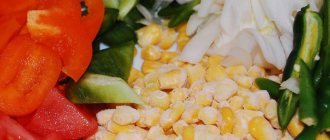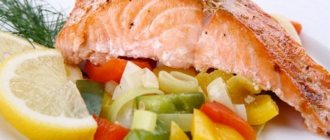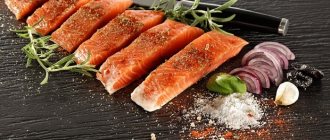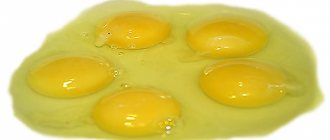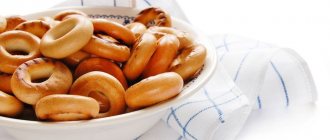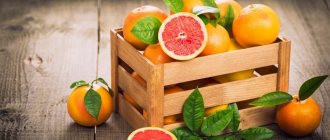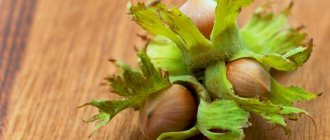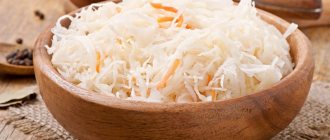01/13/2015 / Fish and seafood
| Lightly salted salmon, BZHU and calorie content per 100 g of product | |||
| Calorie content 195 kcal | Proteins 23 g | Fat 13 g | Carbohydrates 0 g |
Salmon belongs to the salmon family; it is considered an anadromous fish and is a valuable commercial object. The maximum weight of one individual can reach 40 kg, and the length can be more than 1 meter. The fish has small scales and does not have any spots below the lateral line. Habitat: the Atlantic and Arctic Oceans, the Baltic Sea.
In the autumn-summer period, Salmon is able to move to freshwater bodies with the current. Spawning occurs in the autumn, when the fish becomes covered with characteristic red spots on the head and sides. Freshwater Salmon feeds on invertebrates and small fish; marine species prefer to feast on crustaceans.
Composition and calorie content of salmon
Salmon fillet has a rich composition of nutrients. With minimal heat treatment, the meat fully retains its nutritional value.
100 g of fish contains the following elements:
| Substances that make up fish | Quantitative indicator | Brief description of them |
| Squirrels | 23.21 g | Normalize the activity of all organs and systems. |
| Fats | 14.83 g | They replenish energy reserves and normalize metabolic processes in the body. |
| Cholesterol | 1.13 g | Normalizes hormonal balance and participates in metabolic processes. |
| Iron | 0.82 mg | Participates in the formation of hemoglobin in the blood. |
| Zinc | 0.68 mg | Helps strengthen the immune system. |
| Chromium | 0.56 mg | Normalizes glucose concentration. |
| Molybdenum | 0.35 mg | Takes part in metabolic processes in the body. |
| Potassium | 363.22 mg | Ensures normal functioning of the nervous system. |
| Sulfur | 198.91 mg | Normalizes the activity of nerve cells and the concentration of glucose in the blood. |
| Sodium | 58.98 mg | Regulates the production of enzymes in the digestive tract and water-salt balance. |
| Calcium | 9.53 mg | Normalizes blood composition and nervous system activity. |
| Phosphorus | 209.11 mg | Participates in energy metabolism and ensures the strength of teeth and bones. |
| Magnesium | 29.99 mg | Normalizes the activity of the nervous system. |
| Chlorine | 164.13 mg | Regulates the concentration of glucose in the blood. |
| Iodine | 223.14 mg | Normalizes the activity of the thyroid gland. |
| Cobalt | 1.28 mg | Participates in metabolic processes. |
| Copper | 0.58 mg | Normalizes the activity of the cardiovascular system, participates in metabolic processes. |
| Vitamins | A 0.32 mg | Helps strengthen immunity and vision. |
| RR 9.92 mg | Normalizes metabolic processes in the body. | |
| E 2.53 mg | Regulates blood composition and nervous system activity. | |
| B1 0.16 mg | Participates in metabolic processes and supports the functioning of the nervous system. | |
| B2 0.19 mg | Normalizes light perception. | |
| B5 5.63 mg | Participates in metabolic processes and hormone production. | |
| B 6 5.92 mg | Helps strengthen the immune system and ensure normal blood composition. | |
| B12 22.11 mg | Normalizes metabolism and blood composition. | |
| D 6.02 mg | Ensures the formation and strength of bone tissue. |
There are no carbohydrates in salmon meat, which makes it possible to include fish dishes in the menu for people on a diet and with diabetes.
Composition and calorie content of salmon
The energy value of salmon (in kcal) per 100 g depends on the processing method:
- fresh – 154;
- boiled – 151;
- steamed - 134;
- baked – 187;
- grilled – 198;
- fried – 239;
- smoked – 198;
- lightly salted – 201.
The most healthy and nutritious salmon is steamed, boiled and lightly salted.
Application
Salmon is best known to a wide range of consumers in its smoked and lightly salted form. This is usually presented as a cold appetizer or delicacy. This fish is often present in salads and light snacks, and is used as a filling for rolls. Moreover, it can be purchased in ready-salted form or marinated at home with the addition of your favorite spices and seasonings.
But fresh Salmon has a distinct taste, from which it is customary to prepare delicate and appetizing creamy soups. This fish is also suitable for frying, and it can be combined with the most common and affordable products - side dishes, marinades, sauces. To preserve all the nutrients included in the product described, it is recommended to bake it on the grill or in foil in the oven.
Market Analytics
- Top 10 Best Beauty Products in 2022
- Global cosmetics market 2022: an unprecedented test for the global cosmetics industry
- Top 10 Cosmetic Research and Development of 2022
Convenient search for beauty salons on our website
Beauty salons in Moscow Beauty salons in St. Petersburg Beauty salons in Ekaterinburg Beauty salons in Novosibirsk
Latest blog posts on our website
- Naturecream / Properties of the “Sunny” oil itself
- Naturecream / “Sugar” wrinkles - or what glycation can do
- Naturecream / Esterified oils
- Naturecream / Arnica - the magical plant of alchemists
- Naturecream / Tremella Extract - Snow Mushroom Detox for Skin
- Prostye-sovety / How to visually enlarge your lips with makeup
- Naturecream / Apricot kernel oil for face
- Naturecream / MATRIXYL3000 - the best skin elasticity stimulator
- Naturecream / SPF in Natural Oils
- Naturecream / Geranium (Pelargonium) oil for skin health and beauty
Latest forum topics on our website
- Natalya / How to properly make a gelatin mask?
- Mrs._Smith / Badly sunburned! What to do?((
- Ice / Is it necessary to combine fitness classes with a diet?
- Antonova / What can be used for hair loss?
- Radio operatorKat / Who was on a protein diet?
Other articles in this section
| Dried fish Dried fish is often found on store shelves. This type of processing is nothing more than cold drying of the product or its dehydration. The temperature does not exceed +40 degrees. Under favorable conditions (windy and dry weather), the fish is dried in a couple of days. But if we talk about fish that is too large and fatty, drying it can take several weeks. |
| Poached pike Poaching is one of the types of heat treatment of food before subsequent manipulations. Poached pike is considered to be pike that has been cooked with the addition of a small amount of liquid with spices. Moreover, the process takes place in the oven or on the stove in a closed container. |
| Smoked mackerel Mackerel is a very common fish that lives in the temperate waters of almost all oceans. At the same time, this fish can be called quite unpretentious. Very often it is found in those waters where the temperature regime is quite varied. The fish belongs to the mackerel family. This species is extremely popular in industry: the fish is caught in huge quantities, and the demand for it is not becoming less. |
| Granular pink salmon caviar One of the most common and popular fish delicacies is granular pink salmon caviar. It is this variety of red caviar that is produced in the largest quantities. No more than 3 - 4 hours after catching, the caviar is taken out of the fish, the fat and films are removed from it through a special sieve, and then placed in brine, which allows it to be preserved for a long time. |
| Salted pollock caviar Pollock is found in the cold waters of oceans and seas. It is often found in the Sea of Okhotsk, Barents and Japan, as well as in the waters of Monterey and Bering Bay. This fish is of very important industrial importance for Russia, since it is actively caught and sold in wholesale, and is distinguished by its pleasant taste and affordable cost. Not only fish carcasses are valuable, but also their caviar. Thus, punched salted pollock caviar has a high nutritional value, is distinguished by a puree-like consistency, a bright fishy smell, and a pronounced taste. Its color is whitish-beige. |
| Wakame algae They say that wakame is almost the most aggressive marine brown algae on our Earth. Wakame grow very quickly, while they push back their “neighbors” and litter the beaches. But despite everything, they are very tasty and healthy, they are often used in the cuisine of the Japanese, Koreans and Chinese. Wakame belong to the genus Undaria. They have a sweetish taste. They live mainly in the cold waters of China, Korea and Japan. At the end of the 20th century they were discovered in New Zealand, the USA and France. |
| Boiled sea bass Sea bass is a bony fish belonging to the scorpion fish family, prefers to live in the cool waters of the Pacific and Atlantic oceans at a depth of more than 100 meters. Under natural conditions, fish live quite a long time - up to 15 years. The catches include small fish about 20 cm and large ones, reaching a weight of 5-10 and even 15 kg. The main catch fishery takes place in Northern Norway. |
| Smoked trout Trout is a species of the salmon family. This fish lives in the North-West and Transcaucasia, it can be found in lakes. But in order to lay eggs, trout swim to rivers and streams that flow into the body of water in which the fish lives. But it happens that the fish does not swim away and spawns directly in the lake. Once the fry are released, they separate. Some go to live in rivers and streams, while others return to the lake. |
| Mackerel Mackerel fish is better known as mackerel. It is one of the most common game fish in the world. It lives in the Black, Mediterranean, North and Baltic seas. It can be found off the coast of North America and off the coast of Ireland. Norway produces the largest catch of this fish - about 160 thousand tons per year. Mackerel meat owes its popularity not only to its taste, but also to its beneficial properties. |
| Boiled pink salmon Red fish of the salmon family is highly valued all over the world. The most common today is the small pink salmon. Adults gain weight of 5 kilograms, grow more than 54 centimeters, but rarely exceed 77 cm - it all depends on the habitat of the fish. This fish is fished on Sakhalin, Primorye, as well as in the waters of the Arctic Ocean; it avoids warm waters and hot climates. |
The benefits and harms of lightly salted salmon
Lightly salted salmon, the recipes for which are described later in the article, can have both positive and negative effects on the body when consumed.
| Benefit | Harm |
| Helps eliminate depression and nervous tension by normalizing the activity of the nervous system. | May cause an allergic reaction. |
| Increases the body's resistance to various pathogens. | If you buy expired fish or that have been stored improperly, your body may be poisoned. |
| Strengthens and promotes the development of bone and muscle tissue. | May cause increased blood pressure |
| Normalizes the condition of blood vessels and blood composition. | Deterioration of kidney function due to the presence of salt in the finished product. |
| Improves the activity of the cardiovascular system. | Deterioration of the condition in case of gallstones and urolithiasis (due to salt content). |
| During pregnancy, it promotes the normal formation and development of the fetus. | |
| Normalizes the concentration of sugar, cholesterol and promotes weight loss. | |
| Improves the activity of brain cells, increasing memory and alertness. |
Harm from lightly salted salmon occurs when it is consumed excessively, as heavy metals accumulate in fish fillets.
Calorie content of lightly salted salmon per 100 grams
Calorie content of lightly salted salmon per 100 grams is 195.3 kcal. In a 100-gram serving of this fish:
- 23 g protein;
- 13 g fat;
- 0 g carbohydrates.
Read: Calorie content of fried herring
Lightly salted salmon contains a lot of fatty acids Omega 3, Omega 6, selenium, fluorine, zinc, sodium, calcium, vitamins A, E, C, PP.
Contraindications to the use of the product are exacerbations of diseases of the liver, kidneys, stomach, and intestines. Fish will have to be abandoned if water-salt metabolism is disrupted.
How to choose salmon for salting
Salmon for sale can come either from the sea or artificially grown. Fish caught in the sea has the greatest beneficial qualities. It does not contain chemical additives that were used to accelerate growth and increase weight.
How to choose salmon for salting
When choosing fresh frozen salmon, you should pay attention to the following qualities:
- The fish fillet should only be soft pink in color and elastic (when pressed, the fibers quickly straighten). Darker color is characteristic of “old” fish. And the bright pink tone means the use of dyes to give the meat a more attractive appearance;
- the fillet is loose and pale pink in color, which means the carcass has been defrosted multiple times;
- the scales are slightly damp, but without excess shine, without mucus and stains;
- eyes should be transparent and not sunken;
- gills are pink, the presence of a brown tint is characteristic of stale fish;
- When buying fish without a head or fillet, the edges of the cut should be smooth. The blurriness characterizes the soaking of the fish;
- there should be white streaks in the meat;
- The fish has a characteristic marine smell. A fishy aroma develops during long-term storage.
The shelf life of fresh frozen fish is no more than 14 days. When choosing frozen fish, there should be no ice or snow in the packaging. Their presence means repeated defrosting or improper storage.
What's the benefit?
Salmon contains a lot of useful substances. These are vitamins of group B, as well as A, C, D, E and PP. It also contains many trace elements such as sodium, phosphorus, potassium, fluorine, iodine, sulfur, chlorine and others.
Yes, this marine inhabitant is not low-calorie. However, due to the fact that it contains fats and proteins, but absolutely no carbohydrates, the dish you eat will not put extra centimeters on your waist.
Moreover, this product contains the Omega-3 amino acid and several other fatty acids, which promote the breakdown of fat and have an extremely beneficial effect on metabolism. The calorie content of salmon is quite high and yet it is perfect for people who want to lose weight.
In terms of its properties, this sea creature is simply a Goldfish. It is recommended for use by both children and adults. It will be useful for men and women, people engaged in mental work and workers with heavy physical activity.
How to cut fish for salting. Methods, pros and cons
Lightly salted salmon (recipes often call for already prepared fillets) can be prepared in a variety of ways. Cooking may require only the fillet, or the whole fish. It is important to be able to properly cut fish for the chosen salting.
How to cut fish for salting. Methods, pros and cons
Nuances of preparing salmon for salting:
- Rinse the carcass, remove scales, fins and head.
- Remove the insides, rinse the fish with water and dry.
- Next, the fish is cut according to the requirements in the recipe.
Salmon cutting methods:
| Type of salmon cutting | Description of cutting | pros | Minuses |
| Entirely | Salmon can be salted whole, after removing the head, fins and scales. |
|
|
| Pieces | The prepared fish is cut into portions of 3-4 cm, without removing the bones. |
|
|
| Fillet | It is necessary to remove the skin from the cleaned fish in the direction from the head to the tail. It is easily removed due to the layer of fat. The skin must be cut off from the caudal fin. Next, you need to carefully separate the ridge from the fillet, without using a knife. The main bones will remain on the skeleton. If there are small bones in the meat, they can be removed using tweezers. The fillet is ready for salting. |
|
|
| Portioned fillet | Cut the finished fillet into portions |
|
|
Additionally, for salting salmon it is recommended:
- buy fresh or frozen fish;
- use only coarse salt;
- salt only in enamel or glass containers.
The choice of cutting the carcass can be done independently, depending on the further use of the finished meat.
Lightly salted
You can pickle such a delicacy yourself. It will be an ideal snack on the table during any holiday. You can also make a delicious salad or sandwich with lightly salted red fish.
The nutritional value of lightly salted fish will be higher, since the concentration of proteins and water, which is released due to the presence of salt, changes. This product is recommended for those people who are on a protein diet. The benefits of lightly salted red fish are slightly lower than those of steamed fish, but higher than those of salted fish. But the microelements and vitamins in this delicacy are the same as in ordinary fish.
Advice: if you suffer from kidney disease, it is better to avoid eating lightly salted fish.
Classic recipe for lightly salted salmon using the dry method
To salt salmon you will need:
| Main Ingredients | Quantitative indicator in pcs. | Weight in g and ml |
| Salmon carcass | — | 1000 |
| Granulated sugar | — | 20 |
| Sea salt | — | 40 |
| Ground white pepper | — | 5 |
| Fresh sprigs of dill | — | 5 |
Classic recipe for lightly salted salmon using the dry method
Salting sequence:
- Cut the carcass into pieces. Rinse with water and dry.
- Mix salt with granulated sugar and pepper.
- Chop the dill and add to the salt mixture. To stir thoroughly.
- Place the salmon pieces in a suitable size container. Sprinkle each layer of fish with the salt mixture.
- Cover the contents of the pan with a plate of suitable diameter and press down with pressure. Place in the refrigerator.
The fish is ready to eat in 10-14 hours (depending on the size of the pieces).
Recipe for lightly salted salmon pieces in orange juice
To salt salmon you will need:
| Main Ingredients | Quantitative indicator in pcs. | Weight in g and ml |
| Fresh frozen salmon carcass | — | 1000 |
| Cumin seeds | — | 10 |
| Fresh orange | 3 | — |
| Ground coriander | — | 3 |
| Pickling salt, coarse | — | 100 |
| Dill sprigs | — | 5 |
Recipe for lightly salted salmon pieces in orange juice
Salting sequence:
- Cut the carcass into pieces. Bones can be removed if desired.
- Mix cumin, ground coriander and chopped dill. Mash the contents with a masher.
- Squeeze juice from oranges. Boil until ½ of the juice evaporates.
- Lay out the salmon in layers. Sprinkle each layer with the prepared spice mixture.
- Sprinkle the last fish layer with salt and pour cold orange juice.
Keep the pan with fish warm for 1 hour and cold for 8 hours. Cover the container with a paper or cloth towel.
Lightly salted salmon according to a quick recipe with vodka
Lightly salted salmon with the addition of vodka retains its juice and elastic consistency. Instead of vodka in the recipe, you can use cognac, depending on your taste preferences.
To salt salmon you will need:
| Main Ingredients | Quantitative indicator in pcs. | Weight in g and ml |
| Prepared fillet | — | 1000 |
| Vodka | 50 | |
| Pickling salt | 50 | |
| Granulated sugar | 20 | |
| Dill sprigs | 5 |
Lightly salted salmon according to a quick recipe with vodka
Salting sequence:
- The fillet can be used whole or divided into portions.
- Mix chopped dill, granulated sugar and salt.
- Coat the fillet thoroughly with the salt mixture. Place in a container.
- Sprinkle the fillets with vodka and cover the pan with cling film.
- Let the salmon soak in the mixture in a warm place for 2-3 hours.
The fish can be consumed immediately. But it’s better to let it sit overnight in the refrigerator.
Salting fish with lemon
To salt salmon you will need:
| Main Ingredients | Quantitative indicator in pcs. | Weight in g and ml |
| Fresh salmon fillet | — | 1000 |
| Fresh lemon juice | — | 100 |
| Powdered sugar | — | 30 |
| Canning salt | — | 100 |
Salting fish with lemon
Salting sequence:
- Rinse and dry the fillet
- Mix salt and sugar. Add lemon juice (20 ml) to the mixture.
- Brush the fillet on all sides with the salt mixture and place in the pan.
- Pour the remaining lemon juice over the fish fillets.
- Cover the pan with film and place in the refrigerator for 10-12 hours.
Turn the fillet over and leave to salt for another 12 hours.
Lightly salted salmon in brine
To salt salmon you will need:
| Main Ingredients | Quantitative indicator in pcs. | Weight in g and ml |
| Fresh salmon carcass | — | 1000 |
| Drinking water | — | 1000 |
| Coarse salt | — | 100 |
| Lemon juice | — | 30 |
| Dried cloves | 2 | — |
| Black pepper in the form of peas | 2 | — |
| Laurel leaves | 2 | — |
| Allspice in the form of peas | 2 | — |
Lightly salted salmon in brine
Salting sequence:
- Prepare the brine using all the ingredients except the fish itself.
- Cool the brine and strain.
- The fish can be cut into fillets or pieces, as desired. Pour in the prepared brine. The salmon should be completely covered with it. Cover with a lid.
The fish should sit in the refrigerator for a day.
Salting salmon in beets
To salt salmon you will need:
| Main Ingredients | Quantitative indicator in pcs. | Weight in g and ml |
| Fresh salmon fillet | — | 500 |
| Fresh beets, grated | — | 200 |
| Horseradish root, grated | — | 20 |
| Vodka | — | 30 |
| Lemon zest | — | 15 |
| Dill sprigs | — | 5 |
| Granulated sugar | — | 30 |
| Pickling salt | — | 130 |
Salting salmon in beets
Salting sequence:
- Rub the fillet with salt and sprinkle with sugar.
- Mix the horseradish and beets and place the mixture on top of the fillet.
- Sprinkle with chopped dill, lemon zest and vodka on top.
- The fish is wrapped in cling film. And put it in the refrigerator.
The salmon will be ready in 48 hours.
Calorie content of oven-baked salmon per 100 grams
Calorie content of oven-baked salmon per 100 grams is 101 kcal. In a 100 gram serving of fish:
- 8.88 g protein;
- 5.42 g fat;
- 4.79 g carbohydrates.
To prepare baked salmon you need:
- Place 120 g of onion cut into rings on a sheet of foil;
- add 120 g of coarsely grated carrots to the onion;
- Sprinkle 200 g of salmon fillet with lemon juice and place on onions and carrots;
- wrap the edges of the foil so that the juice of the fish and vegetables remains inside and does not flow out onto the baking sheet;
- salt the fish to taste;
- bake the salmon in the oven at 200 °C for 25 - 30 minutes.
Salting the backbone and belly of salmon for beer at home
Lightly salted salmon (this recipe is the most economical) for beer is popular among men.
To salt salmon you will need:
| Main Ingredients | Quantitative indicator in pcs. | Weight in g and ml |
| Belly or spine of salmon | — | 500 |
| Pickling salt | — | 30 |
| Granulated sugar | — | 15 |
Salting sequence:
- Rinse the abdomen/ridge and dry.
- Mix salt and sugar and sprinkle the mixture over the belly/backbone.
- Place everything in a jar with a lid for the pickling period. And place it in the refrigerator.
Serve after 8 hours.
How to salt whole salmon deliciously?
To salt salmon you will need:
| Main Ingredients | Weight (g or ml) |
| Prepared salmon carcass, fresh | 2000 |
| Coarse salt | 200 |
| Granulated sugar | 100 |
How to salt whole salmon deliciously?
Salting sequence:
- Mix sugar and salt and rub the salmon carcass with this mixture.
- Place the carcass in a bag and put it in the refrigerator.
The salmon will be salted in 12 hours.
Salting salmon fillet
To salt salmon you will need:
| Main Ingredients | Quantitative indicator in pcs. | Weight in g and ml |
| Fresh salmon fillet | — | 1000 |
| Pickling salt | — | 120 |
| Granulated sugar | — | 60 |
| Vegetable oil | — | 50 |
| Dill sprigs | — | 10 |
Salting salmon fillet
Salting sequence:
- Mix salt with chopped dill and sugar.
- Rub the fillet with the mixture.
- Place the fish in a tight container or bag. Place in the refrigerator.
- In 24 hours, lightly salted salmon will be ready, after 2 days, lightly salted fillet, and after 72 hours, salted salmon.
- Remove the fillet depending on the desired result. Drain the liquid and brush the salmon with oil. Place in a clean container.
Consume fish within 7 days.
How to salt salmon caviar?
To salt salmon caviar you will need:
| Main Ingredients | Quantitative indicator in pcs. | Weight in g and ml |
| Salmon caviar without film | — | 300 |
| Drinking water | — | 200 |
| Coarse salt | — | 50 |
| Granulated sugar | — | 50 |
How to salt salmon caviar?
Salting sequence:
- Prepare a brine from salt and sugar. Cool to 70 degrees.
- Place caviar in brine for 15 minutes.
- The brine is drained and the caviar is dried for 2 hours.
Place the caviar in a jar greased with vegetable oil. Keep refrigerated.
Trout steak dietary recipe
You already know how you can cook trout in the oven and get a minimum of calories! You can also make a steak and safely include it in your diet for weight loss. The main secret of its preparation will be the presence of a grill pan on which you can fry fish without using vegetable oil! The advantage of such a frying pan is that, due to the corrugated surface, the fish does not come into complete contact with the bottom, releases juice and is simultaneously fried and steamed. An ideal option for those who adhere to proper nutrition.
Salted salmon in oil
Lightly salted salmon (the recipe with the addition of oil allows you to prepare juicy even frozen fish), prepared in this way, can be stored for a long time.
To salt salmon you will need:
| Main Ingredients | Quantitative indicator in pcs. | Weight in g and ml |
| Portioned salmon fillet | — | 500 |
| Vegetable oil | — | 100 |
| Granulated sugar | — | 15 |
| Coarse salt | — | 50 |
Salted salmon in oil
Salting sequence:
- Dissolve sugar and salt in butter.
- Place the fillet in a jar and fill with the prepared oil mixture. Stir and cover with a lid.
After 18 hours, the fillet is ready.
Salmon steak in a slow cooker
Fish prepared according to the proposed recipe comes out very soft and juicy. The following list of products will need to be prepared:
- 2 salmon fillets;
- ½ part lemon;
- a pinch of black pepper (ground);
- a pinch of rosemary.
Cooking time – 50 minutes.
Calorie content – 190 kcal.
Steamed fish preparation technology:
- Divide the fillet into steaks and rub each of them individually with pepper;
- Also sprinkle the salmon with rosemary and leave aside for a while so that the fillet is saturated with the aroma of spices;
- Pour some water into the bowl and place the container for steaming;
- Place the fish there;
- Cut the lemon into thin slices and place them on top of the fish;
- Close the lid and set the device to “Steam” mode. Set the timer for 30 minutes and leave until the characteristic shutdown signal.
What can you cook from lightly salted salmon?
Lightly salted salmon is both an independent dish and an ingredient in salads and appetizers.
Recommended recipes with lightly salted salmon:
| Name of the dish | Ingredients | Cooking rules |
| Canapes |
|
|
| Fish roll |
|
|
| Stuffed eggs |
|
|
| Lavash with salmon and ham |
|
|
Lightly salted salmon fillets can be used to prepare a variety of baguette-based sandwiches. The type and quantity of ingredients is determined as desired.
Nutritional value of fish
To say that salmon has amazing meat is to say nothing. In addition to excellent taste, the fish has a rich chemical composition. It contains Omega-3 fatty acid, the hormone melatonin, which is important for the body, a wide range of amino acids, proteins, vitamins (A, PP, C, B, D, E), minerals, in particular iodine, selenium, phosphorus, chromium, iron, zinc, potassium.
The composition of fresh fish BJU is characterized by indicators of 21.6/6.0/0.0 g, respectively, per 100 grams.
With other cooking options and adding additional ingredients, the data changes. We present a selection of BZHU per 100 grams of product:
- Grilled salmon – 21.8/14.1/0.0 g
- For carrots in the oven - 13.85/6.23/2.47 g
- Steamed – 19.3/14.0/.0 g
- Belly – 25.0/24.0/0.0 g
- Ridges – 20.01/8.1/0.0 g
- Head and fins – 20.8/15.1/0.0 g
- Smoked – 22.5/12.5/0.0 g
- Salty – 22.5/12.5/0.0 g
- Boiled – 22.5/12.5/0.0 g
- Lightly salted – 23.0/13.0/0.0 g
- Baked – 19.9/8.4/0.5 g
- Baked in foil with vegetables in the oven – 14.62/3.96/2.0 g
- On vegetable coat – 7.96/4.97/6.74 g
- With milk-spinach sauce – 15.83/5.86/1.68 g
- Baked in mustard marinade – 19.22/5.55/2.91 g
- Lightly salted with avocado – 1.23/11.08/5.0 g
- With mushrooms in the oven – 16.54/7.5/1.2 g
- Salad “Salmon under a fur coat” – 18.0/24.5/4.3 g
- Rolls with salmon – 140.0/5.0/32.6 g
- Hot smoked product – 24.41/26.13/4.96 g
- Indicators of salmon fish soup – 7.4/2.0/1.6 g
- Broth – 61.4/7.4/0.0 g
- Cream soup – 4.7/2.8/2.9 g
- Steak – 19.39/11.7/1.93 g
- Fillet – 20.0/0.0/15.0 g
- Salmon sandwich – 13.85/6.2/16.8 g
- Fish soup – 3.70/1.69/4.29 g
How to store salted salmon?
Recommendations for storing lightly salted salmon (in the refrigerator):
- When purchasing a finished product, salmon should be stored in the refrigerator for the period indicated on the package, while maintaining the integrity of the package. Once opened, it is recommended to consume the fish within 3 days;
- When prepared at home, fish can be stored for no more than 4 days;
- if the salmon is greased with oil and placed in a sealed package, its shelf life will increase to 7 days;
- If portioned salmon fillets are placed in a jar with vegetable oil and hermetically sealed, the shelf life increases to 3 months. But fish can change the taste;
- You can increase the shelf life, up to 15 days, by adding salt, but then the salmon will become salted rather than lightly salted.
Storage in the freezer is not recommended, as the fish becomes soft after defrosting, and the taste and healthiness change. But the shelf life increases to 6 months.
You can cook lightly salted salmon yourself. The advantage of cooking fish at home is adding salt and spices according to your own taste preferences. It is not recommended to salt a large amount of fillet, since in its finished form it can be stored for no more than 7 days. The fish retains all its nutritional properties if the cooking recipe is followed.
Salmon danger
Of course, like any product, this fish has its contraindications. Not all people are recommended to eat it.
You should beware of red fish if:
- You have allergic reactions to salmon or seafood in general;
- You suffer from urolithiasis and kidney disease;
- you have liver problems;
- Have stones in the kidneys or gall bladder;
- You have inflammation in the gastrointestinal tract;
- You suffer from high blood pressure;
Also, beware of eating raw sea creatures, as they may contain various parasites. A raw product can only be eaten if it has quality certificates and veterinary permits. A fish that is too brightly colored will not do you any good, as it is most likely tinted with dyes. Salmon has a high calorie content and is therefore not recommended for obese people.

